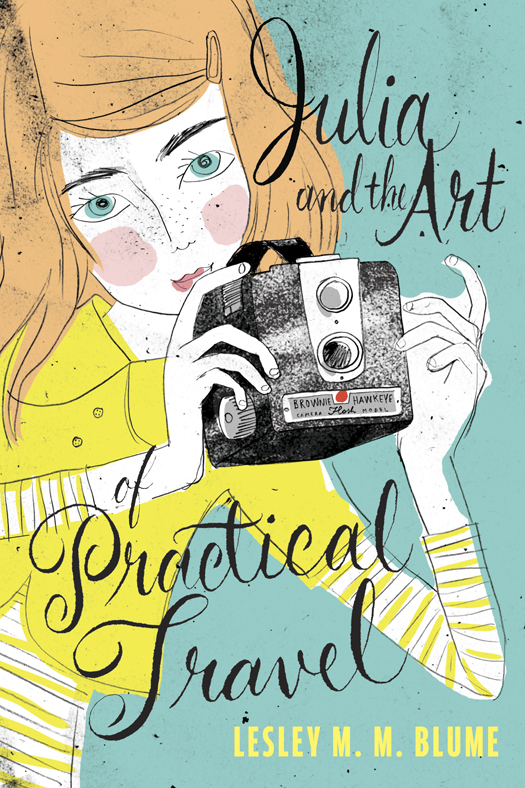
Julia and the Art of Practical Travel
فرمت کتاب
ebook
تاریخ انتشار
2015
Lexile Score
990
Reading Level
4-7
ATOS
5.6
Interest Level
4-8(MG)
نویسنده
Lesley M. M. Blumeشابک
9780385752848
کتاب های مرتبط
- اطلاعات
- نقد و بررسی
- دیدگاه کاربران
نقد و بررسی

January 12, 2015
Eleven-year-old Julia Lancaster’s story begins in 1968 on “the day that my life at Windy Ridge ended and my life everyplace else began.” After Julia’s wealthy grandmother dies, and the family estate in the Hudson Valley is sold, Julia and her Aunt Constance hit the road, determined to track down Julia’s mother, who disappeared three years before. In an old station wagon full of family heirlooms like a silver tea set and oriental carpets—“practical travel things,” according to Aunt Constance—they travel from New York to California. Along the way, privileged, sheltered Julia becomes closer to her reserved aunt and forms many opinions of her own, not always generous ones (“I decided that old-guard New Orleans grande dame meant an old lady who was quite fat and wore lots of face powder and big hats and flowered dresses”). But overall, Blume (Tennyson) offers a touching and entertaining series of adventures, set amid changing landscapes and 1960s culture. Photos Julia takes with her Brownie camera appear throughout. Ages 8–12. Agent: Molly Friedrich, Friedrich Agency.

November 15, 2014
In 1968, after Julia's aunt Constance is forced to sell Windy Ridge, home to the aristocratic Lancasters since the American Revolution, to Tipsy von Lipp (nee Shirley Hicks), the two set off to find Julia's mother, Rosemary, who traded pearls for love beads three years earlier.Julia brings her Brownie camera, and with Lancaster heirlooms-oriental carpets, silver tea service-in steamer trunks, one even lashed to the roof of the station wagon, they drive to Manhattan to stay with Tipsy at her invitation while Aunt Constance combs Greenwich Village searching for Rosemary. Stuck in the suffocating apartment with gloating, vulgar Tipsy, Julia's inspired to play an elaborate practical joke that quickly ends their visit. The droll, meandering road trip across the United States unfolds in spare but telling detail that draws on Blume's poignant imagery. But the inconsistent tone-early, broad farce gives way to pointed pathos-and jerky, episodic plot can jar. There's little sense of the vivid 1960s in the text or Julia's generic photos. Ridiculing silly Tipsy, a shrill hayseed who's never seen an oyster fork (how many young readers have?), makes Julia seem heartless-a preteen Eloise. The urban snobbery has a chilling effect. The liveliest, most evocative scenes are those far from civilization and its discontents; it's in the lonely, arid Texas and Nevada landscapes that the characters come close. Readers who make it to the heartland with her will find the pleasure in Julia's travels. (Historical fiction. 8-12)
COPYRIGHT(2014) Kirkus Reviews, ALL RIGHTS RESERVED.

January 1, 2015
Gr 4-7-Julia Lancaster, 11, lives happily with her very proper grandmother and Aunt Constance in their family's historic home, Windy Ridge, in 1968. She knows that her mother has left her to become a hippie but doesn't have a clear picture of why or what being hippie really means. Julia's life changes drastically when her grandmother dies the next day. The girl's beloved home and all its contents are sold, and she and Aunt Constance leave New York's Hudson Valley to find Julia's mother. They set out in a station wagon jammed packed with the family's "essential" things for travel, including a silver tea set, candlestick, and an assortment of furs and other finery. These are the things, Aunt Constance tells her, that make them Lancasters. Their search takes them on an adventure around the country, and Julia's world broadens with each stop. She sees exactly what hippies are in Greenwich Village; in New Orleans they confer with a voodoo priestess who counsels them that they will see Julia's mother but not find her. In Texas, they enjoy the hospitality of a rancher with a staff of Chinese cowboys, and on through the southwest, where they meet the sheriff and only resident of a deserted gold-mining town. Each character is delightful and quirky, and readers will enjoy all of them. The story comes to a somewhat predictable conclusion, but it hardly matters. This book is filled with familial love and the joy of traveling, and readers will appreciate Julia's journey.-Patricia Feriano, Montgomery County Public Schools, MD
Copyright 2015 School Library Journal, LLC Used with permission.

December 15, 2014
Grades 5-7 Julia's photography is probably the most important thing in her life, as it helps her to zero in on details. Her trusty camera accompanies her on a cross-country journey precipitated by her grandmother's death. She and her aunt Constance need to sell their ancestral home and decide to look for Julia's long-lost mother before Julia is sent to boarding school. Photographic examples of Julia's photos, scattered through the text, help focus the story for readers: a teacup prized by her family, her grandmother's beringed hand, and so on. Set in the 1960s, the book can be heavy-handed in its depiction of hippies, especially in the case of Julia's mother. Still, the colorful journey does reveal important truths for Julia regarding home and family. Constant Constance, originally timid and meek, is ultimately strong and protective. She might not be Julia's biological mother, but certainly fits the bill in every other way. Readers who appreciate stories of family will enjoy going along on this ride.(Reprinted with permission of Booklist, copyright 2014, American Library Association.)

























دیدگاه کاربران